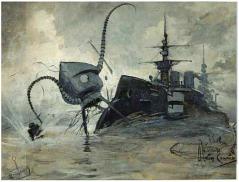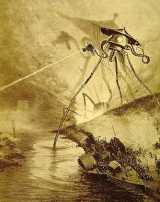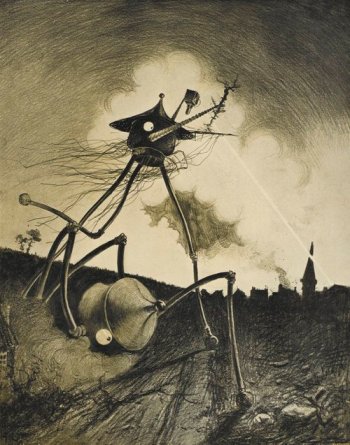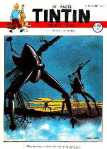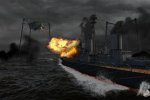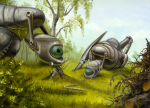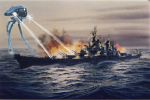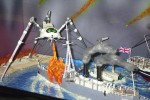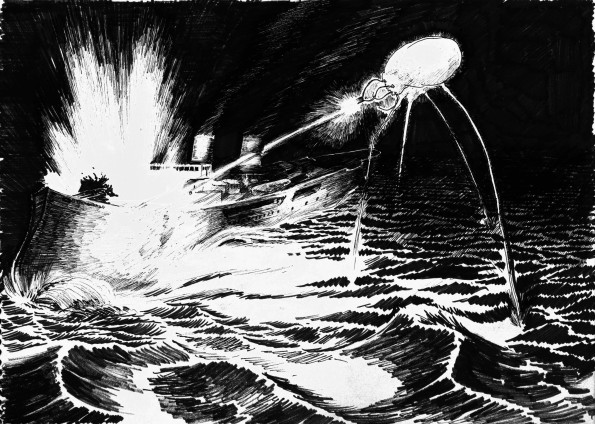Archive
A brief history of tripods
When H G Wells read about the Black War, he found himself thinking “Jesus fuck! What if I wrote a book where aliens came and invaded the British Empire right in its stupid fucking face, and were just genocidal assholes just like the British Empire in Tasmania? What then?”
So he did. And he made the British Martian invaders as disgusting and evil and alien and just wrong as he could. And late one night, hopped up on cheap Turkish tobacco, he had an epiphany: “nothing in nature has three legs, does it? These fuckers gonna be three-legged. Then you’ll know how bad they are.”
The next morning he realised why nothing in nature has three legs: because as soon as it tried to move, it would fall over. So he wrote that instead of walking his three-legged monsters rolled like “a milking stool tilted and bowled violently along the ground.”
The reading, drawing and movie-making public totally agreed with him about the awesomeness of alien invasions and the awesome alienosity of three legged fighting machines. “Fuck yeah, tripods!” they said, all around the world. Even, curiously, in Woking, which he wrote about being flattened and destroyed first and most thoroughly.
But there was less enthusiasm for the “bowling along” rationalization and even less for remembering the whole Tasmanian genocide thing. Which just goes to show that gonzo-imaginative beats sensible, meaningful, and important every time, when it comes to grabbing the public’s excitement glands.
So why am I blogging this, when you can get perfectly good histories of Wellsian Tripods from Wikipedia or the War of the Worlds Wiki? I’ll get to that.
I reckon the next really important moment in Tripod development was Mike Trim’s iconic 1978 painting:
which you probably know from Jeff Wayne’s Progopera. By the time Trim did this, there had already been 80+ years of tripod drawing:
but these hapless tin-men weren’t exactly going to (ahem) set the world on fire. Aside from a tendency toward big heads and spindly legs there wasn’t much consensus about what a Martian tripod should look like – people knew they wanted tripods but they didn’t agree on exactly what that meant.
(amazing gallery of book covers – from which extracts below;)
until two versions pretty much killed all the others. Trim’s, which was really a polished up take on this 1950s effort:
and a beetle-shell, overhanging eaves look that Spielberg would adopt mostly just to avoid agreeing that Trim totally nailed it (lots more views here and here)
that probably derives ultimately from a comic book (the original of which I haven’t tracked down):
So what’s so great about Trim’s painting?
1: it’s a spider. A daddy long legs like you find in the shower.
2: it has two glowing eyes. Other pictures make it clear that those are supposed to be compound bug-type eyes but here they make a recognisable, almost-human face.
And 3: that face is pure scorn. Trim’s tripod threatens without having to move because it melts the Thunderchild’s valiant heart with pure contempt. That’s not just the haughty angle of the head, it’s also the not bothering to dodge pose of the legs and most of all the I shot you right where I wanted to angle of the heat ray. Compare this Spanish hatchet job, where they messed with the painting to fit a narrow format:
Here the face is looking down its murderous nose at nobody. The ship isn’t going to hit it anyway so there’s no question of dodging. In fact maybe it just did dodge, like a bullfighter, and is dropping the rejón de muerte as the Torpedo Ram blunders past. It’s contemptuous, but not idly so.
And so just how iconic is Trim’s painting? How much does it dominate the imaginative landscape? Ahem:
OK. But the real reason I went off down this rabbit-hole is that I saw a godawful bit of lazy 3D and I had to share it in the right context.
See, the confrontation of the Thunderchild and the tripod is one of the big scenes in the book. It’s the definitive moment when the reader understands that the British Empire – and therefore humanity – is completely screwed. The Thunderchild is not the Empire’s biggest ship, but it is its most spitefully violent. It is an outstandingly stupid idea realized as expensively as possible – a ship made to destroy things utterly, no matter how Pyrrhic the victory. It’s a fucking giant steam engine made to ram things with torpedos. And it gets one good strike on a spindly leg before the Martians wise up and melt it. So you’d want that scene to be pretty dramatic, right? Something like this:
only there the drama rather gets in the way of the clarity of what exactly is going on.
Trim’s painting gives you drama, futility, scorn, tragedy and clarity in one neatly pointed triangular composition.
And then we come to this flabby bit of 3D rendering, which gives you absolutely none of that, plus a boring alien cannon doohickey:
Yes, it’s sticking a tentacle up in the air creating tension with the edge of the frame. The horizon line is off communicating a loss of control. And like Trim’s picture we see the point of the Thunderchild’s sacrifice – the steamer full of civilians escaping to France.
But Ugh. Zero character, zero tension. It could be a picture about air pollution. In spite of the fact that the Thunderchild is clearly just about to run that sucker down on pure momentum. It’s… just…
Here, have some alterna-tripods as a palette cleanser:
Still here? This Goliath thing looks like it could be fun. And look, tripod minis! The old Tin Man rides again! Roger Dean’s version as a model. And finally Fimm McCool’s Orkshop has an actually fairly original design!
I could use that.
Against the Steady State Universe
A comment on G+ reminded me of a little bugbear I have with almost all RPG settings:
they tend to have in-built resistance to change. Whether it’s “points of light” or Battletech’s unending, entropic war or even Traveller’s Star Trek – like trawl through multiple tech levels, actual innovation that changes the world is avoided. In fact I strongly suspect that one of the reasons for the perennial popularity of more-or-less medieval settings is that the “medieval” state is (popularly) perceived to be one of stability and stagnation.
Why do we love that so much?
Maybe there’s an elective affinity here with adventure yarns – a static background helps the hero’s dynamism really stand out. The Yankee in King Arthur’s Court or square-jawed Earthling sportsman on Mongo gets to inject his specialness into the passive fantasy world and get validation from it in playtime. The active protagonist’s works can then be isolated and recognized. Or maybe it’s the value that a dynamic community of players gets out of reliably being in sync – we can play DnD or Firefly without much preparation because we’re all on the same page on all important issues right from the start. It’s pretty clear how that’s an advantage for commercial considerations – splatbooks and the like.
Maybe it’s that a static world requires the least metagame knowledge, of the course on which things might change if they were going to change. Lots of video games use some variant on the invention tree to model technological change through the course of play time (an idea which probably traces its origins back equally to Trav’s tech levels (with their logical progression of this before that) and some kind of evolutionary schema), but these things are lame in a tabletop RPG because they short-circuit tactical infinity. And maybe it’s part of the social contract of participating in a world that doesn’t have cellphones – that the players agree not to use their own knowledge to invent them because they accept that the world won’t accommodate them (but if the world might change, then…).
But. If we take history as our guide, then the eras that offer the greatest opportunities to Conan it up from zero to hero are the ones where old systems are being disrupted, where instead of just bobbing along in the tide of human events you can steer a little. Aren’t those potentially the most rewarding campaigns? Ones where you don’t have to stop at becoming king of a province, but might actually change the whole political process and be responsible for saving the serfs from serfdom (or for plunging them into damnation)? Hollywood superheroes tend to be devoted to rescuing the status quo from change but a game doesn’t have to follow suit, right?
So here’s a little metagame knowledge about Tartary (a dangerous thing, for sure), in response to +Stephan Hillenbrand’s critique of primitive post-apocalism in general, to act perhaps as a spur to players’ ambitions. First the critique:
“LosTech” is something I tend to find a rather boring excuse for a stagnating setting. I don’t think people would be in the dark about how a diesel engine works for more than a few months when they have a running example of one lying in front of them, waiting to be dissected.
Also, at least some of the people who understand how trains work should survive any apocalypse. It’s not rocket science, really.
In Tartary there are several obstacles to reforming the world, none of them insurmountable but all of them significant.
First, people are constantly at war. They don’t share information. The size/population of individual cities is limited, so there are limits to the technological work any one of them can do. So a unifier could abruptly change the situation, and something like early 20th century technology could be widely available in short order.
But there are a few other wrinkles to deal with, which actively mess with the effort to settle on a stable scientific paradigm on which disruptive technologies could be based:
1 the physical rules of the universe seem to be a moving target – sometimes visibly as the Weird blows through. Basic devices work reliably, but the more a technology becomes a “black box” the less reliable it becomes. The corollary to this is,
2 “magic” (that is, ways of manipulating the world that are not susceptible to ready explanation) offers a shortcut but one that’s unpredictable, dangerous and encourages secrecy. In practice nobody can resist it because the potential payoff in the short term is wonderful, but it always screws everything up long term, to the extent that
3 it sometimes seems like there’s somebody “up there” keeping things from developing too far, messing with experimental results, putting their thumb on the scale, adding gremlins to devices that get too successful. The really reliable magitech tends to be found rather than made or adapted. Periodically somebody will observe that technologies that render people passive (eg television receivers) tend to be more reliable than those that allow you to actively shape the world (eg recording cameras), but this contention has been made by so many paranoid, power-grubbing mountebanks (with or without funny accents) that nobody serious pays it any mind.
4 there are powerful vested interests who are known to be actively working against large infrastructure projects. There’s no visible Emperor Ming keeping all the princes at each other’s throats but there are nomad hordes and sorcerers and trade networks who profit from the status quo – essentially the buggy whip manufacturers guild has a very good school of assassins in the back.
Which is all to say that the right enterprising gang of revolutionaries could turn this setting on its head. If they could successfully identify and neutralize the players who are working to keep it… the way up it is now.
Natural hazards and magical mishaps on the Plain of Glass
Aside from certain glass-wielding sorcerers and gigantic, white-hot glass worms (the molten cousins of sandworms), the Plain of Glass hosts a number of smaller but no less dangerous creatures:
watch out for the glazing lilies and pitcher plants, which have a disastrously captivating beauty
and especially the Trapper Tchotchke, which can instantly render anyone that touches it into its own brittle filigree.
And beware the omnipresent eyes, that seem to be in cahoots with all those scavengers that have somehow adapted to a silicate diet:
More at Dark Roasted Blend, which also has a fascinating little photo essay on glass art in natural history museums (a topic about which I should know more than I do), which pours petrol on my suspicion that it might’ve been ocean dioramas at AMNH that made HPL first think “you know, I bet I could do something with tentacles.” Or it might have been that he attended the First Church of Nyarlathotep as a child, I’m not sure.
ROLL FOR INITIATIVE!
More generally, Dioramas! Who does not love them is wicked lame.
Finally, in my own private Flash Gordon reality, Grace Jones is the Eternal Barbarian Queen and hula hoops are the Sacred Circlets of Authority, so this bit of reality bleed might be kinda my fault. Sorry about that, fans of normality.
I bet her maj is a big Grace fan.
That is all.
Zak’s awesome psionics system, plus some scrawling from me
So, ages ago I asked Zak for a non-sucky psionics system that wasn’t just another magic system, because it seems to me that the whole psychic power thing should be distinctive. And he very graciously invented one on the spot, and I rather gracelessly buried it at the bottom of another tl:dr post because I wasn’t quite sure why he hadn’t published it himself.
Today I’m going to rectify that. Here’s what he said:
1. Once per day, period.
2. If you want to be a psionic PC you are distracted and fucked up, -1 to con and dex.
3. You must concentrate for 3 rounds in combat or 20 seconds. No physical interruptions allowed but you can hear noises or be in the presence of combat.
4. After the 3 rounds you can “hold” the release of the power up to 2 rounds if you like.
5. Psi power is based on traumas and horrors your PCs has witnessed. To wit: the power consists of the PC being able to manifest the effect of any natural power of a living being (or undead or whatever demons are) s/he has seen used to date. The effect of a ghoul’s paralysis, a medusa’s stare, a sorcerer’s intelligence, an ogre’s strength, a hydra’s regeneration etc.
6. If the ability in question can normally affect another creature it can be projected up to levelx5 feet. So like if your PC had seen a giant, the PC could telekinese with the giant’s strength up to 5 feet at 1st level and at 200 feet at 20th level.
6. Spells do not count as powers, but the spell-like abilities of demons and devils do.
7. Feedback: after manifesting the power, the PC must make a wisdom check (ie roll under wisdom, minus the monster level of the creature being mentally evoked) or will save (at a DC of 10+monster CR) depending on system.
8. A failed feedback save/check causes hp damage equal to the level of the creature evoked. A botched feedback save causes that much damage to everyone in a creature-level x 10′ radius including the psion.
9. If the psion is ever knocked unconscious by feedback (alone), this is a traumatic experience that will cause him/her to gain one minor insanity.
10. At the GM’s discretion this may also extend to natural phenomena such as lightning discharges, etc. If there are described dreams in the game, any supernatural ability observed in the dream may be used. If the effective level of the phenomenon is unclear, roll 2d4
11. Instead of the normal botch rules you can use the Dark Heresy weird phenomena psychic phenomena chart which is pretty cool.
Now this seems pretty much perfect for straight-up DnD characters – when you start you haven’t seen anything you can channel and then as you adventure the terrifying awesomeness you encounter becomes a form of treasure you can inflict on others (man oh man, the grief Skeree could inflict on people from playing in Zzarchov’s games). But what if you were a starting character who somehow, say, got uncontrollable psi powers from, completely hypothetically here… being operated on by Greys while you were down in the weapons pit in Carcosa Wacky Races? Then you would undeniably have use-now powers but no experiences to guide them. And it would be uncontrolled, which adds more of a live grenade vibe. What then?
Roll a D6 when the dice gods declare your powers have built up too much and must be vented…
1. old-fashioned psychic blast – your chance to hit is your CHA, the target’s chance to save is their WIS, difference in level between you is a mod on the to hit roll. 3D6+level mental damage: if their hit points are exceeded, they fall unconscious and take the remainder of the damage against their WIS, which they can maybe heal back through story events. Blaster saves vs WIS to avoid also being knocked unconscious.
2. psychic bridge with nearby person (determine randomly unless there’s eye contact when the fit strikes). Lasts D10 minutes. Roll D6 for effect of the bridge:
1 = twins! each mirrors the other’s actions until the link is broken;
2 = suggestion – you implant one geas on target;
3 = suggested – target implants one geas on you;
4 = fate brothers – you are now charmed by each other, cannot hurt, must protect;
5 = body swap – instantaneous and permanent;
6 = evil twin – the target always knows where you are and what you’re doing, and will work to screw up everything you try to achieve.
3. Homing beacon for psychic, astral and psionic entities. Sure, ghosts and whatnot, but also mind flayers, githyanki, nightgaunts, mi-go etc.
4. Purge your inner demons. Like that time your mum hit you with the iron, or you were naked and everyone was laughing at you? All those things go hopping and jumping and slithering right out of you in a cascade, like extras from Hieronymous Bosch’s Garden of Earthly Delights. You feel fantastic: lighter, shriven, free. Also you lose 1d6 SAN or 1 point of WIS because, you know, there goes the old superego.
5. Limited precognition. Lasts 1d6 days, works basically like danger sense but for dice rolls. You still make the rolls as normal but if something awful happens you get to say “ah but but but…” and make up some reason for why you should get an extra save to get out of the mincing machine in time.
6. Bang. Brains everywhere. Stuff like resurrection should still work, as long as it doesn’t need an intact body. 1d6 SAN loss for all your friends.
Adventure seed for CoC: Heidegger’s Necronomicon
Fourteen deaths on campus and the semester hadn’t even started yet. The only thing that linked the victims was that they had all responded to the following post-doctoral grant proposal:
It has often been observed that the works of Martin Heidegger (most notably Being and Time) are absolutely incomprehensible, if not actually gibberish. Two hypotheses have been put forward to explain this observation: (1) that Heidegger was trying to express something for which common communication strategies are inadequate; (2) that Heidegger just wasn’t very good at communicating.
Further, it has come to the researchers’ attention that prolonged exposure to Heidegger’s works appears to significantly degrade the ability of his readers to communicate. Attempts to explain Heidegger – notably the famous works by Hubert Dreyfus and Wrathall & Critchley – all end up pretty much as incomprehensible as the original, while works that merely cite Heidegger are frequently less comprehensible around the locus of citation. Following this observation a third hypothesis is proposed: that some aspect of Heidegger’s works has an active effect on readers’ cognitive and communicative faculties.
The researchers propose to investigate this apparent phenomenon. One group of researchers will attempt an interpretation of Heidegger’s works similar to that used on the celebrated, and comparable, Voynich Manuscript, approaching his writings as artifacts of unknown meaning or purpose and undertaking a detailed textual and non-textual, symbolic analysis of them, in the hope of uncovering patterns. Simultaneously, a second group of researchers will observe the interpreting group closely for signs of degradation in their abilities to communicate, analyze or think rationally without, themselves, coming into contact with Heidegger’s works. Finally, both groups will be continuously monitored by video surveillance equipment and behaviour-analysis software, which will notify a third group in the event of a significant change in the behaviour patterns of either or both of the first two groups.
To avoid self-selection biases or contamination of the data or groups by previously-exposed scholars, the three groups will be drawn at random from incoming freshmen in the academic new year, who will have to demonstrate ignorance of Heidegger’s works in a double blind test.
Call of Cthulhu is missing an act
Through all this endless back and forth about when and why it absolutely isn’t OK to drop an encounter on somebody that you thought they might like, a realization came to me – one that James Maliszewski apparently had years ago but, y’know, I can be a bit slow.
The best way to start an adventure path is probably from a sandbox.
James does this all the time in Dwimmermount, by dangling hooks in front of his players, which they just happen to find while they’re doing what they do every day – looting Dwimmermount. Here’s a magic item. It transports you somewhere mysterious, where there’s a load of peculiar stuff, that seems relevant to Dwimmermount. There’s a scroll which tells you about another location elsewhere. The guy who translates scrolls wants magic red spoons: he’ll trade info for them. Info that leads into or back to or across other plots. And so on.
Yeah, I know, it’s not rocket science. But thinking about it made me realize how often I haven’t done it in the past. How whole games have somehow decided to forego this bloody obvious method.
Including my most favouritest game of all, Call of Cthulhu, which routinely starts with some bunch of freshly rolled characters receiving a disturbing letter from their uncle – ie a mission briefing that tells you “the plot’s that way, go engage with it.” Now I’d felt uncomfortable about this method in the past. I’d agreed with other players that it was “a bit contrived,” that the PCs often didn’t have good reasons for abruptly getting in up to their necks in trouble that would probably kill them, after driving them mad. But I hadn’t really thought about what was wrong with it from an RPG point of view.
Here’s what I think is wrong: it robs your 3 act drama of its first act, which is normally dedicated to getting to know the PCs. Zak pointed out that CoC is about The Menace, and that’s what everyone cares about, and nobody’s really interested in the 1920s as a setting itself. And that’s Act 2 stuff* – the antagonist or antithesis – but skipping Act 1 means you don’t lay out the stakes – what The Menace menaces. And that’s probably why The Menace always threatens to unmake the world and all creation – because that’s a stake the players can get without any context. But if you had an Act 1 and you actually knew and cared about your characters and they had some history and some bit of the world that was their own to defend, then The Menace would have more purchase in the world: it would have specific things to get its claws into. And the PCs would have more tools or situations against which to place it.
So I still love CoC, but in future I think I’m going to seed CoC adventures in other, persistent settings. Let’s say the PCs are pirates. They do their pirate thing: they annex some secluded coves and get some reliable fences for their loot and try to recruit crewmen and follow rumours of richly-laden ships and periodically pretend to go legit so they can knock over a warehouse or a governor’s palace and so on. And while they’re doing this they get to hear about disturbing stuff, and they get to choose what to do about that. And in this way they can build up a general picture of the world and make their own deductions about what might and might not fit in it. And they’ll get to hear about some things that definitely don’t fit: that menace the world they’re adapting themselves to exploit.
The Orthodox School of Robbery would chime in at this point and say “yes, yes, but you’re still thinking about it wrong right up front there: you’re not running a CoC game at all, you’re running pirates, and if you try to force your players into one when they came to play pirates they’ll be pissed off – because you’ll be railroading in their sandbox.” Yeah well, obviously it’s player directed: as a DM I’d have to chill, have NPC schemes going on but no overall plot and all that. Sure. But there’s a cost to the pure sandbox model, too: where CoC classically lacks a first act, the classical sandbox never gets out of first. Because nothing else in the world is as important as the PCs and their decisions, the world can never develop its own “agency,” to use the buzz-word of the month. Start actually making important changes to the world because the PCs didn’t engage with that scheme you told them about and you’ll be accused of railroading them into engaging with it.
Well, perhaps. But that’s actually how the real world works. That would be a breathing, dynamic world with consequences both for action and inaction. Maybe in such a world the opinions and actions of NPCs could also matter. In a world like that there might even be room for an Act 3 that didn’t consist purely of bookkeeping – counting loot, leveling up, looking for the next dungeon.**
* CoC seems to be deliberately stuck in Act 2 all the time, actually: Sandy Petersen’s onion skin model, in which solving each mystery leads to a bigger, deeper one, is an ingenious method for turning Act 3 resolutions back into Act 2 introductions of the antithesis. And it’s orthodox dogma that you cannot eventually win.
** Note, I’m not talking about an “end game” here, I’m talking about closing particular chapters or threats or opportunity windows in the world, not the End of the Campaign.
Reward for getting this far:
Mirror of Heissenbergen. Using this mirror the PCs can capture one creature or object from the world. It will then remain in the mirror until released (say, by a magic word or gesture). If the creature or object has some sort of will of its own, roll a D30 and subtract the creature’s wisdom or charisma from the result. It will escape from the mirror in that many days, unless released earlier. If nothing has been captured but the mirror is set to release anyway, small hot stones will spit intermittently out of the mirror until the release order is canceled.
A surfeit of ogres. Every road out of town abruptly has exactly the same ogre encounter on it. If these ogres are dispatched they will be replaced within d12 hours with a duplicate. The ogres are being put there by the wife of a retired adventurer who lives in town. She’s worried her husband will leave unless he’s discouraged, and she’s got hold of a magic or ultratech replicator from his hoard, that works something like the mirror, above. It’s set to release ogres right now, so that’s what she’s using. If the PCs find the replicator it will have exactly 2 charges left. The retired adventurer may tell the PCs where he got the replicator for a consultancy fee, payable half up front, half on return, but there’s no way he’s going back in there.
in which I finally get hit upside the head hard enough to get why CoC is “gothic horror”
I was going to tidy this up into a proper post, but I kinda like it in ragged form. If you have no patience for a meandering mumble today I recommend you move right along.
If, like me, you didn’t get why CoC was “Gothic” right away, I recommend noisms’ two year old blog post on understandable vs non-understandable fantasy, which he terms “classicist” and “romantic.”
It was this lucid discussion that made me realise that CoC is the most Romantic of games (despite HPL’s atheism and its association with various stripes of “rationalist” readers). The point being, it’s all about confronting the sublime with your empiricist brain and discovering that the said empiricism is inadequate for holding it – that, moreover, the sublime will break it.
Well, it’s not just that. I think I could’ve given that explanation years ago. It’s more that, in the war between Classicist enlightenment and Romantic mysticism, CoC is kind of a steamhammer, repeatedly smashing up the rationalist works and demanding to be placed beyond their power. The Cthulhoid creatures defy cataloguing, characterization through comparison, or even description because they will not be tamed inside your encyclopedia. Characters repeatedly try to do exactly this – find taxa for them and so on, and they are punished with the removal of their reason. Only hubristic villains ever claim to have plumbed the deepest mysteries, and their claim signals their downfall. Experts are useless in most cases: the tablet you found is made of no known metal, the writing on it is in no known language. In fact, CoC pretty much reverses Sherlock Holmes’ dictum: once you have eliminated the possible, you’re starting to engage with the adventure. The sublime is kept conspicuously behind a curtain, we are told, for the reader’s protection, and it is a fundamental precept of the game that this curtain will not be more than tweaked, lest the game itself end.
Well, actually because the DM should (quite explicitly) not be able to show you what the monsters will do if left unchecked, because it’s unmaginable.
So CoC is one answer to noisms’ question: how would you make a Romantic (mysterious, magical, magical-realist) game, rather than a systematized one which is liable to be “superheroically banalifying“? Magic in CoC is for affecting the PCs with – PC use of magic is actively discouraged, because it inevitably banalifies. And if you do get to use magic, you’re not going to understand it enough to use it tactically – it’s all desperate fingers scrabbling at the scroll, or flapping away at the control panel, hoping for a lucky connection.
Like noisms, I am drawn toward fantasy because of the Romantic, the mysterious: I want to be surprised. But surprise is anathema to player agency: what comes within the remit of the player’s ability inevitably has to become tools, not mysteries – the PCs are inevitably, resolutely non-Romantic intruders in the magical world. They have to react to the Romantic as an external influence. But they can get a good time out of struggling to understand the mysterious – in the case of magic, out of trying to figure out a system, so that they eventually get a kind of tactical grip on it. True, that’ll leach the mystery out of the thing so understood, but hopefully your game has many more mysteries behind every one they figure out.
And maybe that’s why I admire Ars Magica (1 and 2e) so much; outside the magic system the world is utterly Romantic: there’s no monster manual, just a few suggestions on how to build monsters. There’s no European Capitals splatbooks (OK, maybe there are now), just a map and hints of what might be out there. But most of all the magic system itself is like that – just comprehensible enough that you might try stuff out, just opaque enough that you won’t be sure if it’ll work or not. Deliberately open-ended, so that research and spell invention are core activities of the game. And also open-ended in terms of power, so that you can know what your own limitations are and plan a little ahead, but you have no idea how far others have gone, or how deep the rabbit hole goes.
Real maps are the best maps
…well sometimes. And this is one of those times.
If you’re writing RPG stuff then obviously you need to know about Strange Maps. If you’re looking for a map for your fantasy world you could do a lot worse than just grabbing Kerguelen,* AKA “the Desolation Islands” (enough maps here for a whole Sea of Os’r, BTW).
The real archipelago (with names, if you like) has a total land area of 2,786 square miles, but thanks to the fractal magic of coastlines you could make it stand in for any size you like. I particularly love the crazy folding thing going on in the north and centre, with all those fjords and mountains: a military disaster waiting to happen. Not sure what to populate it with? Strange Maps has some suggestions:
“The feral cats are rarely seen, except for those who live at the base and are almost domesticated. Most cats are really wild animals, more so than the rabbits (which are everywhere, and do much damage to the ground) or even the elephant seals laying on the streets. Kerguelen cabbage is a protected species and we are forbidden to eat it… although of course, every year people do try to prepare some. It is said to have a terrible taste!”
…and Kergolus… an animal of indeterminate species, although his furriness and quadripedality seem to suggest an affinity with… badgers, stoats and ferrets [and wolverines, natch. Ed]. But his peculiar shape was of course suggested by the outline of Grande Terre – so we could say that Kergolus is a native species, unlike all the cats, rabbits, sheep and reindeer introduced by man.
The real place is desolate but strangely beautiful, and would fit a Cthulhuvian game well. It inspired some nice early modern explorer/periplum art. The only way on or off the island is via the Marion Dufresne, a freighter out of Réunion, 3,490 km (2,169 mi) away. That’s ten days’ sailing, if the seas aren’t too rough. So it could be your perfect isolated research station horror setting (its scientist population varies from 70 in winter to 110 in summer), or Lost type island, where the PCs wreck during a yacht race gone awry. The evolution of ways to map and visualise the place lends it a nicely hallucinatory quality, like you can’t quite see what’s there.
For my needs I probably wouldn’t have it be uninhabited, though: scaling it up, I could put a whole Middle Earth or Tekumel or Korad in there, with cities and civilisations trickling down all sides of snowcapped Mount Meru and nomads raiding across the eastern plains. Maybe, in true Victorian explorer fantasy style, it’s secretly inhabited with a fauna that’s so Other we wind up calling them spirits, like Prospero’s island.
But those other little sneezes of volcanic rock off the mainland? Those are totally cartoon desert islands.
Update: This city occupies part of the ricebowl cup down in the southwest corner.
* not to be confused with this Kerguelen, which looks perfectly nice, too, but doesn’t quite have the same RPG pull, sorry.
Belated Joesky: the haunted swamp
With apologies to Land of Nod, Tim Powers, David Byrne and Fatboy Slim, all of whom I am ripping off unmercifully:
We’re talkin’ about the whole man
When he’s whole we see him smile
But take just one part away from the rest
And he’s a a crocodile.
The trouble with magic is, we really don’t know what it’s for. Oh, certainly, its effects are useful: those everlasting lights, the firebolts, the purses that can hold a horse or a house or a dragon’s horde of treasure. But why were these things made? Was it for the effects we know? Then why are there so many spells that merely unmake things? That send, for instance, gold or food or water or dead bodies away? Or that subtly change their weight or colour or nature? Take that spell that turns men into animals, for instance. Why do they never turn back? Why does one man turn into a ram and another into a jackal?
That one, at least, we know some little thing about. Because of that village in Sweetmarsh where they found the scroll and before anyone knew, every last soul had been turned into some creature or other, except four little children locked in the root cellar. It seems that spell sheers off some vital piece of the soul, the one that makes us human. Perhaps one of the five essences from which we are all made. And what’s left is an animal. An enraged, confused, miserable animal. And the piece, shorn away, goes drifting about the swamp, possessing the weak, scaring the tired and unwary with visions, and maybe just maybe attaching itself onto the animals of the swamp, to make those abominations we hear about, from time to time, lurching out of the marsh, frightening the village’s new inhabitants out of their houses.
What happens if you drop a gelatinous cube into the Tumbling Dungeon?
This, by the way, is also what the formless spawn of Azoth looks like when it’s wandering around a vertical dungeon and refusing to fall apart like a proper liquid would. Only black. And here’s Telecanter’s tumbling dungeon.
…there are moments in that movie where it really looks like some spirit or shroud of a ghost rising to wreak its terrible vengeance, and moments when it looks exactly like a liquid, and moments when its sharply cut edges are spooky all by themselves.
So thinking about Telecanter’s hall of four spheres*** it occurs to me that the Indiana Jones billiard ball is not the only hazard that could be flopping aimlessly around an unstable dungeon surface. And checking back on the old Gel Cube I find I like it more than I remember. I’d always thought of it as (a) a stupid trick by a bored DM and (b) a simple herding device for a recalcitrant party. But what if you’re investigating the lair of the mad alchemist or wizard? Isn’t this exactly the sort of experiment you’d half expect to find? And what if the party are sleeping or resting or incapacitated in the dungeon by other threats? Isn’t this just the kind of thing to make them wish they were more alert?**** Why do folks love the Shoggoth and hate the Cube?
So how could this elderly trainwreck of a monster provide some additional fun? First I’d say make it hard to burn, and have it do damage to armor first – that’d give even your recently paralysed MU one round of clothing protection before he’s Cubefood. Mechanically, I’d say the Cube doesn’t get stuck if the corridor’s a bit too small: it’s deformable enough that if there’s a hole under it that’s more than, say, 70% of its area, it will slowly sink into it, and keep sinking until it finds a new cubic space to occupy.* Oh, and the whole “slow” thing; I say Cubes and shoggoths alike aren’t slow as such, they just have poor acceleration and deceleration. They can speed up or slow down by 1mph (or say 3mph for shoggoths) a round, up to a maximum of 60-70mph. Certainly fast enough to do lots of damage to themselves and anything else in their way (a 10′ cube of water is more than 30 metric tons!). And they can turn, say, 90 degrees per round, -10 degrees for every 1mph they’re currently going forward. So most times you encounter them they’re just moving like supertankers in port: slowly and carefully. But if they get a good head of steam up as they run off the cliff into the lake they’ll tumble and bounce and skip across the surface. At least a couple of times.
Then:
1. What if it were averse to something – salt, say? Or attracted to catnip or fresh meat? Then the PCs could herd it around the dungeon themselves. But it won’t go through closed doors – it doesn’t feel a gap. And if it comes to the end of a corridor it’ll reverse. Long-term dungeon inhabitants will know all these tricks, of course.
2. See how it doesn’t digest dungeon walls? Clearly there’s some list of what’s digestible. Clearly you could carry offcuts in indigestible flasks or larger containers and use them as… artillery ammo? Because it won’t splash but it’s a pain to get rid of once it’s in your granary/breastplate/stable. And I don’t see why you shouldn’t be able to snip bits off it – the mechanics for “defeating” it are vague about just what that means. I’d allow cutting weapons to sever it, thereby turning one big hazard into lots of smaller ones.
3. Alchemists are always “digesting” stuff in their flasks. Now it’s a treasure/McGuffin: go get me some Gel. And like Spawn up there, it doesn’t want to be used, so you’ll have to chase it around the dungeon once it’s realised it shouldn’t be chasing you. And it can knock stuff over and close doors and slip down cracks and into the sewer system. And it can swallow all the keys, even if it can’t use them.
4. because “mindless” just isn’t fun. It should have some sort of intelligence, just an entirely alien one. It should know enough that it could find a lair, sneak out at night and paralyse/digest a couple of cows or children, and then disappear by morning. So you start finding these bleaching skeletons around the place and frightened villagers but no explanation. And if it’s not water-based but something else altogether then it might show up in deserts or volcanoes or as the unintended consequence of universe-rending dimensional gates and passwalls.
5. Of course if it is water based it might be able to alter its size/viscosity in water. Drinking water. Which gives me an idea for displacement puzzles – do you have to float a boat/platform/statue, flood an area, swim up somewhere? Get the Cube into the water column and see how much taller it gets (I’ll spare you all my computer adventure game type weight-on-a-seesaw, catapult, airlock, hydraulic and wobbly floor puzzles. You get it). With the right breadcrumb trail and an indigestible howdah you could enlist it to carry stuff out of the dungeon for you.
6. Or like an anemone it could adopt a different shape in water. And/or like a nudibranch it could swim surprisingly efficiently, turning a slow, lumbering land threat into a serious (magical) lake guardian.
7. What if it could communicate, like Thumper, by slapping on the ground, sending booming waves of shock around the dungeon? Who/what would it call? What if it could break through thin sections of wall/floor or crumbling stone bridges?
8. What if it’s one form of the last “stone” left over from constructing the sky and therefore theologically highly important? What if you could compress it into an ooze golem? What if it brought you stuff – clues – to lead you around the dungeon to the cheese, and eventually enticed you into the mindswap device, the same trick its current mind fell for many years ago? Then you could have the fun of taking the mindswapped character’s player into the next room and offering them a choice: either continue as the Cube or play for a while as a ringer for the DM – someone who’s trying to pose as the player’s previous PC but who knows nothing about the story so far, and who had their own reasons for coming down into this dungeon all those moons ago.
* No, I’m not going to model the mass to surface tension ratio or viscosity on this thing: my sense is that if it’s about as dense as water and somehow manages to maintain a cube shape then it could probably be repurposed as some kind of super-material, so hand-waving is all you’ll get here.
** Telecanter, when are you going to link all these posts together or provide an index page or something? This is awesome stuff and it deserves to be collated and popped on Links to Wisdom. srsly.
*** put the cube and the spheres together and you get… a big mess? Bits of caustic jelly everywhere? Deadly pinball? Something that can move the balls around so they go places gravity wouldn’t just push them?
**** yes the being digested to death thing is suitably icky, but I’d guess it kills mostly by suffocation. 10′ of water is considerable pressure, but not a crush attack. But if it falls on you it’ll do… 2d6 per 10′ of fall? And engulf you instantly.


